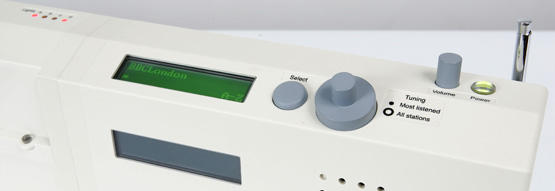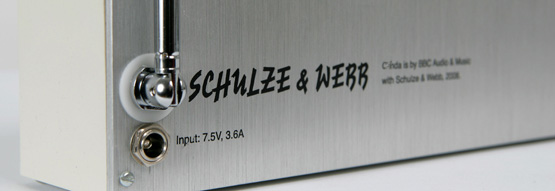Olinda is a prototype digital radio that has your social network built in, showing you the stations your friends are listening to. It’s customisable with modular hardware, and aims to provoke discussion on the future and design of radios for the home.
MORE There are also photos and a pamphlet.

Social Networks in Physical Products
Six lights on Olinda show when a close friend is listening to the radio, using wifi and Radio Pop, the BBC’s website for sharing ‘now playing’ information. Each light is a button: you can tune in to listen along with them, discovering new stations via your social network.
A friend will always appear at the same light, so you can write or draw on the radio to label it, and the lights are bright so you’ll know a friend has started listening from across the room.

Consumer Electronics Learning from the Web
Olinda includes a connector on the side to allow for all kinds of extra modules adding functionality to the base radio, and – because the interface is simple – home adaptation too.
On the Web, users are in charge of customising and adapting their experience. Key to this are the programmer interfaces offered by services such as Flickr that allow third party developers to create and sell new applications to add functionality.
Similar interfaces exist in physical products, like the iPod dock connector enabling a market of peripherals adding value to the iPod itself. But this is rare. On the Web, the simplicity and openness of interfaces has led to widespread use, including widgets and content syndication.
Olinda attempts to learn from this. Its hardware interface already joins the base unit with the friends module. By buying extra modules – or by making their own using the open interface – listeners can adapt their product over time, perhaps adding a remote control or recording. The Olinda pamphlet gives a few ideas of where this might be taken.
The hardware interface is made a feature with sprung copper connectors, and magnets mounted in rounded guides pull the modules together to a solid whole. It’s kept visible behind a clear, orange cap, and begs to be used.

Interactions and Experiences
Olinda has two dials to tune: the outer scroll stations alphabetically; the inner one scrolls only your most listened.
(That’s another lesson from the Web: we like that Web browsers autocomplete those addresses you’ve visited before so you don’t have to type the whole thing again. Likewise, why should a listener configure station presets when the radio already knows their listening habits?)

Where Now?
Consumers increasingly expect their products to contribute to their social network, connect to the internet, and involve them in creative ways, whether that’s by offering ways to extend the product with extra modules at home, or simply with playful customisation. This has been identified as Generation C. The Web is at the forefront of meeting these expectations.
Consumer electronics, and all kinds of physical products, can and should learn from the Web. Let’s marry social networks and lessons from the Web with the powerful experiences and shelf appeal exemplified by toys and gadgets, and make a new kind of product.
Olinda is the first step of this exploration with home digital radio. A small number of fully functioning prototypes show that it’s possible to design social, Web-like experiences using industry standard DAB chip-sets, and conventional manufacturing techniques.
We hope this project provokes as many thoughts for you as it has done for us.

Credits
Olinda was commissioned by BBC Audio & Music Interactive R&D. Thank you John Ousby, Tristan Ferne and Amy Taylor.
Schulze & Webb would like to thank: Alex Chadwick; Jeff Easter; Frontier Silicon; Andy Huntington; James King; NXT Technology; Prototyping Solutions; and Paul South.
Olinda uses Venice 5 by Frontier Silicon, and the speaker is by NXT Technology, using Balanced Radiator Technology.
Olinda is designed and built by Schulze & Webb Ltd in London, UK.
More
- Get the Olinda pamphlet (PDF)
- See photos in the Flickr pool (get in touch for press photos)
- Read posts about Olinda on the Pulse Laser blog